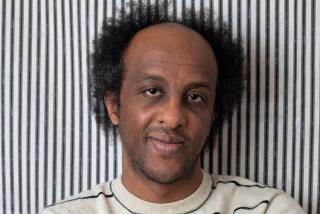‘The Museum of Innocence’ by Orhan Pamuk
- Share via
When the Turkish Nobel Laureate Orhan Pamuk was invited to give the annual Charles Eliot Norton Lectures at Harvard this fall, he chose as his title “The Naïve and the Sentimental Novelist.” Kemal, the protagonist and first-person narrator of Pamuk’s latest, “The Museum of Innocence” may be naive and sentimental -- as well as willful and self-absorbed -- but the author of this mesmerizing, brilliantly realized new novel is anything but. Pamuk, who has taught comparative literature at Columbia, became the first Turk to win a Nobel when he was awarded the 2006 literature prize. He is that rare thing, a creator of sophisticated, intensely literary fiction, who is also his country’s bestselling writer. In part, that’s because of his work’s accessibility and his willingness to adapt conventionally popular genres, like historical and detective stories, into multilayered, character-driven novels.
In his acclaimed novel “Snow,” for example, a series of suicides among village young women forbidden to wear Islamic head scarves becomes the backdrop against which conflicting notions of tradition and modernity play out in a society caught in transition between those two poles.
Partly because of that book’s success, and partly because the 57-year-old Pamuk became the center of international human rights agitation in 2005 when he was arrested and put on trial for insulting “Turkishness” by speaking openly about the Armenian genocide and massacre of the Kurds, many American readers are likely to bring political expectations to his work. ( Turkey has a history of being hard on its writers. In 1951, its great modernist poet Nazim Hikmet was stripped of his citizenship for insulting the government. His citizenship was posthumously restored earlier this year.) Pamuk’s novels, however, don’t fit neatly into such pigeonholes. “The Museum of Innocence” is essentially a novel of erotic obsession and of love and loves lost, remembered, recovered and, then, lost (again) to all but recollection. It begins thus, with two lovers in bed:
“It was the happiest moment of my life, though I didn’t know it. Had I known, had I cherished this gift, would everything have turned out differently? Yes, if I had recognized this instant of perfect happiness, I would have held it fast and never let it slip away. It took a few seconds, perhaps, for that luminous state to enfold me, suffusing me with the deepest peace, but it seemed to last hours, even years. In that moment, on the afternoon of Monday, May 26, 1975, at about a quarter to three, just as we felt ourselves to be beyond sin and guilt so too did the world seem to have been released from gravity and time.”
Kemal is a 30-year-old businessman, graduate of an American university, making his desultory way through a career in one of his wealthy father’s businesses. He lives with his parents in Istanbul’s wealthy Nisantasi neighborhood, where Pamuk -- who originally trained as an architect to please his father -- grew up and still resides. Kemal has an active social life with a wide but claustrophobic circle of friends, all children of secularized, wealthy families, the progeny of modern Turkey’s founder Kemal Ataturk’s forced de-Islamization. Everyone drinks and smokes and looks to Paris for fashion. Pamuk’s Kemal, in fact, is set to announce his engagement to Sibel, the French-educated daughter of another wealthy family.
Then, while shopping for a Jenny Colon handbag for his fiancée, he encounters a distant relative, the much younger Fusun. She becomes the object of his erotic obsession and, after he takes her virginity, he attempts to make her his mistress. However, Fusun, who harbors ambitions of cinematic stardom, rejects Kemal and marries an unattractive -- and unsuccessful -- writer of art films.
Unable to shake off his obsession with Fusun, Kemal loses Sibel to a wealthy friend and through the years continues to haunt the apartment where Fusun and her husband live. Gradually, Kemal becomes an object of pity and, then, scorn to friends. Throughout these years, he steals objects associated with Fusun -- cigarette butts, cups and glasses, underwear, bits of jewelry, which he hoards in the apartment where they once met. This collection will become the nucleus of his “Museum of Innocence” after a final, searing tragedy.
Along the way there are marvelous and transporting evocations of Istanbul -- a city of which Pamuk has written movingly before -- and fascinating insights into a society living very much on the unstable borders of contemporary life between the Islamic and Western worlds.
There is a bit of knowing -- and revealing -- postmodern fun at the end of “The Museum of Innocence” when Kemal encounters the distinguished writer “Orhan Pamuk” and describes his global wanderings through museums of various kinds as well as his own project. “Then I looked carefully into our author’s eyes: ‘While Flaubert was writing “Madame Bovary,” inspired by his beloved Louise Collet, to whom he had made love in horse carriages and provincial hotels, just as in the novel, he kept in a drawer a lock of her hair, as well as a handkerchief and a slipper of hers, and he would, from time to time, take these things out to caress them looking in particular at the slipper to recall how she walked -- as you certainly know from his letters, Orhan Bey.’
“ ‘No, I didn’t know that,’ he said. ‘But I love it.’ ”
Pamuk follows with his own story of dancing with Fusun and a night spent drinking and talking with Kemal. In the end, it is the author’s voice that recalls Kemal and brings his story to conclusion for reasons we’ll leave the reader to discover.
At the end of this long -- sometimes languorous, sometimes fevered, always engrossing -- tale, two thoughts suggest themselves. One is summed up in one of the aphoristic reflections with which Pamuk has studded his narrative: “Real Museums are places where Time is transformed into Space.” The other is this: For those isolated by self-regard, love is a euphemism for obsession and romance, merely a synonym for desire.
“The Museum of Innocence” deeply and compellingly explores the interplay between erotic obsession and sentimentality -- and never once slips into the sentimental. There is a master at work in this book.
More to Read
The biggest entertainment stories
Get our big stories about Hollywood, film, television, music, arts, culture and more right in your inbox as soon as they publish.
You may occasionally receive promotional content from the Los Angeles Times.










